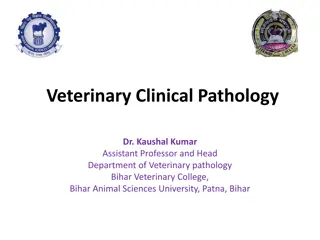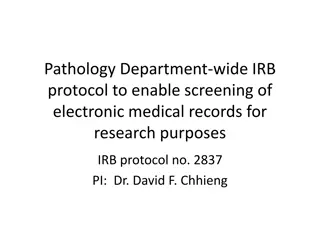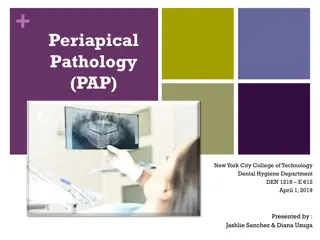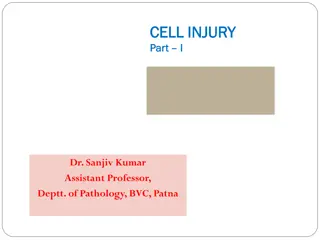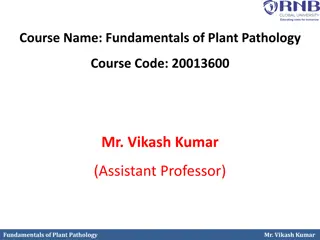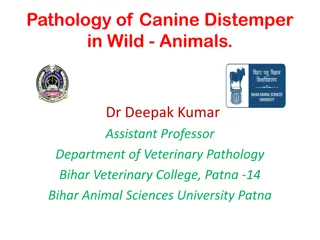Unit 1: Introduction and History of plant pathology
The science of plant pathology, which studies plant diseases and aims to protect the food supply by improving plant survival in unfavorable conditions. Explore the causes of plant diseases, their symptoms, and methods of prevention and control.
5 views • 13 slides
Next - Gen Digital Pathology Conference | New Technology and Advancements
We at MarketsandMarkets are extremely thrilled to announce our \u201cMarketsandMarkets 2nd Annual Next-Gen Digital Pathology Conference\u201d scheduled to be held on 21st \u2013 22nd March 2024.\n\nRegister Now @ https:\/\/events.marketsandmarkets.com\/next-gen-digital-pathology-conference\/register
2 views • 5 slides
Understanding Steatotic Liver Disease: Importance, Epidemiology, and Pathology
Steatotic liver disease, including metabolic dysfunction associated steatohepatitis (MASLD) and metabolic associated alcoholic liver disease (MALD), is a common cause of liver test abnormalities in the United States. Risk factors such as obesity and metabolic syndrome can lead to advanced fibrosis a
2 views • 44 slides
Understanding Tumor Classification and Nomenclature in Pathology
This slideshow provides an overview of tumor classification, nomenclature, and key concepts in pathology. It covers the definitions of neoplasm, tumor, and oncology, the classification of tumors into benign and malignant categories, as well as the importance of stroma in tumor behavior. It also expl
4 views • 61 slides
Understanding Cellular Pathology: Response to Stress and Disease Predisposition
Explore the hallmarks of cellular pathology, including factors influencing disease predisposition such as genetics, environmental factors, and lifestyle. Delve into the cellular response to stress, adaptive and pathological reactions, and key stressors disrupting cellular homeostasis. Uncover how ce
0 views • 51 slides
Understanding the Natural History of Disease Development and Prevention
The natural history of disease development outlines the progression of a disease in an individual without intervention, from exposure to outcome. Learning objectives include defining prevention terms, understanding disease severity, prevention levels, and intervention measures. Studying disease prog
4 views • 16 slides
Understanding Fundamentals of Plant Pathology with Mr. Vikash Kumar
Dive into the world of plant pathology with Mr. Vikash Kumar, an Assistant Professor, as he covers the course objectives, introduction to plant diseases, definitions, scope, responsibilities, and the importance of plant diseases. Learn about identifying diseases, pathogen nature, disease management
0 views • 10 slides
Principles of Epidemiology: Understanding Disease Occurrence and Surveillance
Epidemiology is the study of disease patterns, factors influencing disease occurrence, and the core functions of surveillance, field investigation, and analytic studies. It involves understanding disease characteristics, natural history, and evaluating the effectiveness of activities to mitigate dis
1 views • 25 slides
Fundamentals of Plant Pathology with Mr. Vikash Kumar - Course Overview and Important Pathogens
This course with Mr. Vikash Kumar covers the fundamentals of plant pathology, including identification of diseases, pathogen nature, disease management strategies, and principles. Learn about important plant pathogenic organisms such as fungi, bacteria, and fastidious vascular bacteria, along with s
0 views • 12 slides
Insights into Tyzzer's Disease: An Overview of a Bacterial Infection in Laboratory Animals
Tyzzer's disease is an acute bacterial infection affecting rodents and rabbits, caused by Clostridium piliforme. Discovered in 1917 by Ernest Tyzzer, the disease is characterized by necrotic lesions in the caecal mucosa, liver, and heart. Initially known as Bacillus piliformis, it was later renamed
2 views • 21 slides
Laboratory Automation in Chemical Pathology: A Comprehensive Overview
Laboratory automation in chemical pathology involves the use of control systems to minimize human intervention and improve efficiency in conducting tests. The historical background, types of automation, benefits, total laboratory automation, and important considerations are discussed in detail.
1 views • 25 slides
Renal Block Pathology Practical: Anatomy and Histology Overview
The Renal Block Pathology Practical provides a comprehensive insight into the anatomy, structure, and histology of the kidney nephrons, including normal and abnormal conditions such as acute kidney injury. The session covers topics like the structure of the nephron, normal kidney gross anatomy, rena
3 views • 47 slides
Post-Sophomore Fellowship Program in Pathology and Scholarly Pursuit at University of Pennsylvania Medical Center
Student Fellowship Program in Pathology at University of Pennsylvania Medical Center offers a unique work-study experience for students interested in pursuing a career in pathology. The year-long program includes rotations in Anatomic and/or Clinical Pathology, a dedicated research project, and tail
2 views • 4 slides
Understanding Disease Control and Prevention in Epidemiology
This article discusses disease control processes in epidemiology, including reducing disease incidence, duration, and transmission. It covers public policy interventions, elimination, eradication, and extinction of infectious agents. It also highlights preventable causes of disease and different lev
2 views • 10 slides
Overview of Veterinary Clinical Pathology and Importance of Anticoagulants
Veterinary clinical pathology involves the laboratory diagnostics and analysis of bodily fluids and tissues to support the diagnosis, treatment, and prevention of diseases. This field encompasses interpreting blood tests, blood smear examinations, and the use of various anticoagulants in specimen co
3 views • 46 slides
Understanding Medical Terminology: Suffixes in Pathology and Procedures
Explore how suffixes play a crucial role in medical terminology by indicating procedures, conditions, and diseases. Delve into suffixes related to pathology, such as -algia for pain, -itis for inflammation, and -megaly for enlargement, as well as procedure-related suffixes like -centesis for surgica
0 views • 11 slides
Understanding Cerebral Palsy: Causes, Risk Factors, and Pathology
Cerebral Palsy (CP) is a clinical syndrome characterized by motor dysfunction and non-progressive brain damage affecting an immature developing brain. This article explores the definition, risk factors during prenatal, natal, and postnatal periods, and the pathology associated with CP, including dif
1 views • 38 slides
Pathology Department IRB Protocol for Electronic Medical Records Screening
Pathology Department's IRB protocol enables the screening of electronic medical records for research purposes, allowing members to review patient records and pathology slides. By fulfilling specific requirements and obtaining blanket IRB approval, researchers can access and analyze patient data for
0 views • 16 slides
Understanding Acute Pancreatitis: Pathology, Pathogenesis, and Clinical Features
This educational material delves into the pathology, pathogenesis, and clinical features of acute pancreatitis, detailing the causes, morphological changes, and diagnostic challenges associated with this medical condition. Detailed explanations and images help enhance understanding for medical profe
1 views • 28 slides
Understanding Special Stains in Pathology
Special stains in pathology provide crucial diagnostic information beyond routine stains like H&E. They help highlight specific tissue components like carbohydrates, amyloid, nucleic acids, lipids, microorganisms, connective tissues, pigments, and minerals. This article delves into the classificatio
0 views • 19 slides
Understanding Plant Pathology: Importance, Scope, and Objectives
Plant pathology, also known as phytopathology, is the study of plant diseases and their management. It covers the causes, symptoms, and impact of pathogenic organisms on plants. The field aims to understand the interactions between plants and pathogens, develop control methods, and reduce losses in
0 views • 6 slides
Understanding Periapical Pathology in Dental Hygiene
Periapical pathology involves diseases around the tooth apex, such as abscesses, granulomas, cysts, and more. This presentation delves into identifying and differentiating these conditions, highlighting symptoms and radiographic features of each. Understanding these pathologies is crucial for dental
0 views • 12 slides
Understanding Cell Injury and Adaptation in Pathology
Rudolph Virchow's concept of disease starting at the cellular level highlights how cells constantly face challenges in maintaining homeostasis. The plasma membrane acts as a barrier against external stressors, but when cells face excessive physiological stresses or pathological stimuli, they adapt o
0 views • 16 slides
Pathology of Pox Virus in Wild Animals by Dr. Deepak Kumar
Pox viruses can affect wild animals, with Monkeypox emerging as a significant zoonotic virus in Central and West Africa. The disease shows similarities to smallpox but is less severe. Pox lesions are characteristic signs of infection, and outbreaks have been documented in regions with a history of s
0 views • 16 slides
Understanding Grammatical Development in Speech-Language Pathology
Explore a broader perspective of grammatical development in speech-language pathology focusing on noun and verb phrase elaboration. Learn about identifying and elaborating noun phrases, substitution tests, and the elements of an elaborated noun phrase. Gain insights into clinical approaches and lang
0 views • 28 slides
Using Scanners and OCR for Pathology Report Collection
Los Angeles Cancer Surveillance Program has achieved 100% pathology report collection through a new approach involving scanners and Optical Character Recognition (OCR). The program aims to improve efficiency in obtaining and processing paper pathology reports, replacing insecure transportation and s
0 views • 29 slides
Screening for Peripheral Vascular Disease in Patients with Coronary Artery Disease
Patients with coronary artery disease should be screened for peripheral vascular disease as it is a frequent integrator of global cardiovascular risk. The association of atherosclerosis in various arterial diseases highlights the importance of identifying multisite artery disease. The prevalence and
0 views • 23 slides
Human Disease Symptom Network: Understanding Disease Relationships Through Symptoms and Genes
The Human Disease Symptom Network (HSDN) is constructed using a large-scale medical bibliographic records database to form a network of human diseases based on symptom similarities. By integrating disease-gene associations and protein-protein interaction data, correlations between symptom similarity
0 views • 37 slides
Understanding Bacterial Characteristics in Plant Pathology
This course delves into the fundamentals of plant pathology, focusing on the identification, nature, and management strategies of plant diseases caused by bacteria. Topics include the morphology of phytopathogenic bacteria, their characteristics, shapes, and cell envelope structures. Gain insights i
0 views • 17 slides
Understanding Plant Pathology: Reproduction and Classification of Bacteria
This course on Fundamentals of Plant Pathology, led by Mr. Vikash Kumar, covers essential topics such as disease identification, pathogen nature, disease management strategies, pathogen classification, and plant disease diagnosis. It delves into the reproduction and classification of plant pathogeni
0 views • 16 slides
Understanding Bacterial Diseases of Fish: Columnaris Disease Overview
Columnaris disease, also known as Saddleback disease, is a common bacterial infection in fish that is often brought about by poor handling and high stress levels. This disease manifests as tail and fin rot, leading to rapid fish mortality. The causative organism, Cytophaga (formerly Flexibacter), is
0 views • 21 slides
Evolution of Plant Pathology: From Ancient Remedies to Modern Discoveries
Uncover the rich history of plant pathology, from ancient practices in Vraksha Ayurveda to modern breakthroughs by scientists like Anton de Bary and Alexander Fleming. Explore the development of mycology, key discoveries in disease management, and the impact of plant pathogens on historical events l
0 views • 16 slides
Decoding Genetics: Insights from Alzheimer's Disease Symposium to Type 2 Diabetes Study
Explore the latest findings from the Alzheimer's Disease Genetics Symposium 2019 on disease mechanisms, drug targets, and genetic pathways. Dive into the progress made by the Alzheimer's Disease Genetics Consortium over the past decade. Transition to a Genome-Wide Association Study uncovering suscep
0 views • 42 slides
Epidemiology and Pathology of Brain Tumors - Overview and Incidence Statistics
This information provides an in-depth overview of the epidemiology, classification, and pathology of brain tumors. It covers the relative incidence of various brain tumors, including astrocytoma, glioblastoma, meningioma, and others. The data also includes statistics on the occurrence of brain tumor
0 views • 98 slides
Liver Disease Burden in Tower Hamlets
Dr. Somen Banerjee, Director of Public Health in London Borough Tower Hamlets, highlights the concerning liver disease mortality rates in the area, with high incidence of cirrhosis, cancer, and hepatitis B and C. The data reveals a significant burden of liver diseases such as Non-Alcoholic Fatty Liv
0 views • 18 slides
Understanding Tuberculosis and Lung Cancer in Respiratory Pathology at KSU
Explore the detailed pathology of Tuberculosis (TB) and Lung Cancer through images and descriptions prepared by experts at the Pathology Department of King Saud University (KSU). Discover the features of TB such as epithelioid and giant cell granulomas, Ghon's complex, caseous necrosis, miliary TB,
0 views • 52 slides
Understanding Inflammatory Bowel Disease: Crohn's Disease and Ulcerative Colitis
Inflammatory Bowel Disease (IBD) encompasses Crohn's disease (CD) and ulcerative colitis (UC), chronic conditions with immunologic basis. This article delves into the epidemiology, pathophysiology, and differences between CD and UC, highlighting clinical features, pathology, and complications like a
0 views • 42 slides
Ultrastructural Alterations of Renal Tissue in a Male Patient with Fabry's Disease
Fabry's disease is a rare X-linked lipid storage disorder characterized by deficient lysosomal alpha-galactosidase A activity. This condition primarily affects males, leading to chronic kidney disease and progression to end-stage renal disease. Kidney involvement is a critical aspect, and high doses
0 views • 24 slides
Canine Distemper in Wild Animals - Pathology and Disease Overview
Canine distemper virus (CDV) poses a significant threat to various carnivore species, including domestic dogs, foxes, wolves, raccoons, bears, and others. This highly contagious disease has been linked to fatalities in lions and emphasizes the importance of understanding its pathology and impact on
0 views • 10 slides
Understanding Viral Pathogenesis: Causes and Consequences
Viral pathogenesis involves the process by which a virus leads to disease, exploring the interplay between viral and host factors. It encompasses the concepts of virulence, viral disease, and the effects on infected cells and the host's immune response. Changes within infected cells, including cell
0 views • 26 slides














